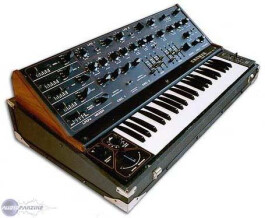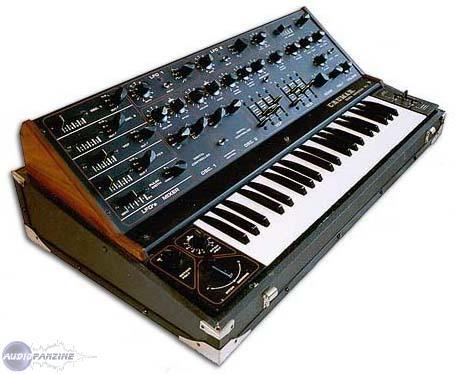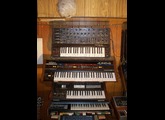View other reviews for this product:
« Adendums, corrections and my impressions »
Published on 03/21/17 at 23:04
Value For Money :
Correct
Audience:
Anyone
First of all this is one of the machines I'd delved deeply into. I paid 100 because this one was a rust bucket  . I paid 400 for another that was an easier repair and sold it for over 1000 as I recall. These are a unique machine. The realistic MG-1 by moog is the most similar in basic architecture. But the ds-2 is better in many ways.
. I paid 400 for another that was an easier repair and sold it for over 1000 as I recall. These are a unique machine. The realistic MG-1 by moog is the most similar in basic architecture. But the ds-2 is better in many ways.
(btw my web site has a detailed page on it for troubleshooting tips... and in my virtual studio tour a sound sample of it with my modified glide that extends it to 9 second sweeps or so)
The original Digital controlled oscillator (allegedly) synth was the DS-1 also from earlier 1978. It lacked the poly organ section which is totally separate from the rest of the synth until it is mixed into the vcf and vca section. It also uses the same oscillator design though as all three in the DS-2 and two in the DS-1 (of which a tiny number..maybe 150 were produced..whereas a few thousand I believe of DS-2 exist). These oscillators are based around the 74LS221 multivibrator chip. ANALOG CONTROL (not digital) charges the timing capacitor for the chip. Hence it's really an ACDO I suppose we could say. THe output is digital. The control is analog for perfectly smooth bender operation. THe glide however is actually a 12bit number being incremented and decremented through a DAC which then has the glide pot in series with it's output... and this current drives a discrete clock circuit that outputs the stepping clock for the counter....and the value is constantly being compared to the target value by a bit comparator. So that when it reaches target the inc. or dec. process stops. In this way it emulates what a typical portamento circuit does in a fully analog synth. No shortcuts in this beast! Analog circuits only in the signal path once tones are generated. THe waveforms themselves however are not generated using analog converters like in most DCO synths (eg. Roland JX, or Siel DK600 etc.) but rather octave dividers are employed and the outputs are proportioned to created digital approximations of Saw and Triangle waves. Hence the ringy overtones that add a charming chirpy sensation to bass sounds when filter is open .
.
So there is no synthesizer quite like it. Real analog delays so S+H of the 2nd LFO for instance can be introduced. Spectacular with the resonance up. The glide time extension switch adds a 1M resistor in series w/ the 100K slider. I recommend replacing it with a 5M pot if you can find one like I did that fits that same hole. Way more useful since the 100K pot is virtually useless once you flip the 1M into series with it. Very simple mod. Well there's my first review on here of one of my favorite monosynths. I'm a big fan of the classics of course as well as octave cat, Yamaha CS units, SH5 if I could afford one and SH3a. The DS2 is the most unique of the entire field really.
(btw my web site has a detailed page on it for troubleshooting tips... and in my virtual studio tour a sound sample of it with my modified glide that extends it to 9 second sweeps or so)
The original Digital controlled oscillator (allegedly) synth was the DS-1 also from earlier 1978. It lacked the poly organ section which is totally separate from the rest of the synth until it is mixed into the vcf and vca section. It also uses the same oscillator design though as all three in the DS-2 and two in the DS-1 (of which a tiny number..maybe 150 were produced..whereas a few thousand I believe of DS-2 exist). These oscillators are based around the 74LS221 multivibrator chip. ANALOG CONTROL (not digital) charges the timing capacitor for the chip. Hence it's really an ACDO I suppose we could say. THe output is digital. The control is analog for perfectly smooth bender operation. THe glide however is actually a 12bit number being incremented and decremented through a DAC which then has the glide pot in series with it's output... and this current drives a discrete clock circuit that outputs the stepping clock for the counter....and the value is constantly being compared to the target value by a bit comparator. So that when it reaches target the inc. or dec. process stops. In this way it emulates what a typical portamento circuit does in a fully analog synth. No shortcuts in this beast! Analog circuits only in the signal path once tones are generated. THe waveforms themselves however are not generated using analog converters like in most DCO synths (eg. Roland JX, or Siel DK600 etc.) but rather octave dividers are employed and the outputs are proportioned to created digital approximations of Saw and Triangle waves. Hence the ringy overtones that add a charming chirpy sensation to bass sounds when filter is open
So there is no synthesizer quite like it. Real analog delays so S+H of the 2nd LFO for instance can be introduced. Spectacular with the resonance up. The glide time extension switch adds a 1M resistor in series w/ the 100K slider. I recommend replacing it with a 5M pot if you can find one like I did that fits that same hole. Way more useful since the 100K pot is virtually useless once you flip the 1M into series with it. Very simple mod. Well there's my first review on here of one of my favorite monosynths. I'm a big fan of the classics of course as well as octave cat, Yamaha CS units, SH5 if I could afford one and SH3a. The DS2 is the most unique of the entire field really.
Audio examples
00:0002:00





